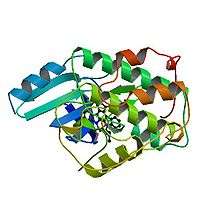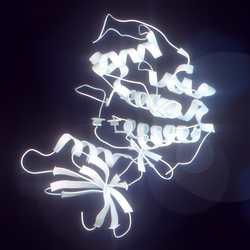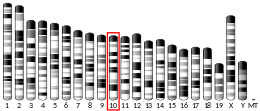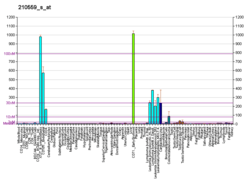Cyclin-dependent kinase 1
Cyclin-dependent kinase 1 also known as CDK1 or cell division cycle protein 2 homolog is a highly conserved protein that functions as a serine/threonine kinase, and is a key player in cell cycle regulation.[5] It has been highly studied in the budding yeast S. cerevisiae, and the fission yeast S. pombe, where it is encoded by genes cdc28 and cdc2, respectively.[6] In humans, Cdk1 is encoded by the CDC2 gene.[7] With its cyclin partners, Cdk1 forms complexes that phosphorylate a variety of target substrates (over 75 have been identified in budding yeast); phosphorylation of these proteins leads to cell cycle progression.[8]
Structure

Cdk1 is a small protein (approximately 34 kilodaltons), and is highly conserved. The human homolog of Cdk1, CDC2, shares approximately 63% amino-acid identity with its yeast homolog. Furthermore, human CDC2 is capable of rescuing fission yeast carrying a cdc2 mutation.[7][9] Cdk1 is comprised mostly by the bare protein kinase motif, which other protein kinases share. Cdk1, like other kinases, contains a cleft in which ATP fits. Substrates of Cdk1 bind near the mouth of the cleft, and Cdk1 residues catalyze the covalent bonding of the γ-phosphate to the oxygen of the hydroxyl serine/threonine of the substrate.
In addition to this catalytic core, Cdk1, like other cyclin-dependent kinases, contains a T-loop, which, in the absence of an interacting cyclin, prevents substrate binding to the Cdk1 active site. Cdk1 also contains a PSTAIRE helix, which, upon cyclin binding, moves and rearranges the active site, facilitating Cdk1 kinase activities.[10]
Function

When bound to its cyclin partners, Cdk1 phosphorylation leads to cell cycle progression. Cdk1 activity is best understood in S. cerevisiae, so Cdk1 S. cerevisiae activity is described here.
In the budding yeast, initial cell cycle entry is controlled by two regulatory complexes, SBF (SCB-binding factor) and MBF (MCB-binding factor). These two complexes control G1/S gene transcription; however, they are normally inactive. SBF is inhibited by the protein Whi5; however, when phosphorylated by Cln3-Cdk1, Whi5 is ejected from the nucleus, allowing for transcription of the G1/S regulon, which includes the G1/S cyclins Cln1,2.[11] G1/S cyclin-Cdk1 activity leads to preparation for S phase entry (e.g., duplication of centromeres or the spindle pole body), and a rise in the S cyclins (Clb5,6 in S. cerevisiae). Clb5,6-Cdk1 complexes directly lead to replication origin initiation;[12] however, they are inhibited by Sic1, preventing premature S phase initiation.
Cln1,2 and/or Clb5,6-Cdk1 complex activity leads to a sudden drop in Sic1 levels, allowing for coherent S phase entry. Finally, phosphorylation by M cyclins (e.g., Clb1, 2, 3 and 4) in complex with Cdk1 leads to spindle assembly and sister chromatid alignment. Cdk1 phosphorylation also leads to the activation of the ubiquitin-protein ligase APCCdc20, an activation which allows for chromatid segregation and, furthermore, degradation of M-phase cyclins. This destruction of M cyclins leads to the final events of mitosis (e.g., spindle disassembly, mitotic exit).
Regulation
Given its essential role in cell cycle progression, Cdk1 is highly regulated. Most obviously, Cdk1 is regulated by its binding with its cyclin partners. Cyclin binding alters access to the active site of Cdk1, allowing for Cdk1 activity; furthermore, cyclins impart specificity to Cdk1 activity. At least some cyclins contain a hydrophobic patch which may directly interact with substrates, conferring target specificity.[13] Furthermore, cyclins can target Cdk1 to particular subcellular locations.
In addition to regulation by cyclins, Cdk1 is regulated by phosphorylation. A conserved tyrosine (Tyr15 in humans) leads to inhibition of Cdk1; this phosphorylation is thought to alter ATP orientation, preventing efficient kinase activity. In S. pombe, for example, incomplete DNA synthesis may lead to stabilization of this phosphorylation, preventing mitotic progression.[14] Wee1, conserved among all eukaryotes phosphorylates Tyr15, whereas members of the Cdc25 family are phosphatases, counteracting this activity. The balance between the two is thought to help govern cell cycle progression. Wee1 is controlled upstream by Cdr1, Cdr2, and Pom1.
Cdk1-cyclin complexes are also governed by direct binding of Cdk inhibitor proteins (CKIs). One such protein, already discussed, is Sic1. Sic1 is a stoichiometric inhibitor that binds directly to Clb5,6-Cdk1 complexes. Multisite phosphorylation, by Cdk1-Cln1/2, of Sic1 is thought to time Sic1 ubiquitination and destruction, and by extension, the timing of S-phase entry. Only until Sic1 inhibition is overcome can Clb5,6 activity occur and S phase initiation may begin.
Interactions
Cdk1 has been shown to interact with:
See also
Mastl
References
- GRCh38: Ensembl release 89: ENSG00000170312 - Ensembl, May 2017
- GRCm38: Ensembl release 89: ENSMUSG00000019942 - Ensembl, May 2017
- "Human PubMed Reference:". National Center for Biotechnology Information, U.S. National Library of Medicine.
- "Mouse PubMed Reference:". National Center for Biotechnology Information, U.S. National Library of Medicine.
- Morgan, David L. (2007). The cell cycle: principles of control. London: New Science Press. pp. 30–31. ISBN 978-0-19-920610-0.
- Nasmyth K (April 1993). "Control of the yeast cell cycle by the Cdc28 protein kinase". Curr. Opin. Cell Biol. 5 (2): 166–179. doi:10.1016/0955-0674(93)90099-C. PMID 8507488.
- Lee, Melanie; Nurse, Paul (Jun 1987). "Complementation used to clone a human homologue of the fission yeast cell cycle control gene cdc2". Nature. 327 (6117): 31–35. doi:10.1038/327031a0. PMID 3553962.
- Enserink JM, Kolodner RD (May 2010). "An overview of Cdk1-controlled targets and processes". Cell Division. 5 (11): 11. doi:10.1186/1747-1028-5-11. PMC 2876151. PMID 20465793.
- De Bondt HL, Rosenblatt J, Jancarik J, Jones HD, Morgan DO, Kim SH (June 1993). "Crystal structure of cyclin-dependent kinase 2". Nature. 363 (6430): 595–602. doi:10.1038/363595a0. PMID 8510751.
- Jeffrey PD, Russo AA, Polyak K, Gibbs E, Hurwitz J, Massagué J, Pavletich NP (July 1995). "Mechanism of CDK activation revealed by the structure of a cyclinA-CDK2 complex". Nature. 376 (6538): 313–320. doi:10.1038/376313a0. PMID 7630397.
- Skotheim JM, Di Talia S, Siggia ED, Cross FR (July 2008). "Positive feedback of G1 cyclins ensures coherent cell cycle entry". Nature. 454 (7202): 291–296. doi:10.1038/nature07118. PMC 2606905. PMID 18633409.
- Cross FR, Yuste-Rojas M, Gray S, Jacobson MD (July 1999). "Specialization and targeting of B-type cyclins". Mol Cell. 4 (1): 11–19. doi:10.1016/S1097-2765(00)80183-5. PMID 10445023.
- Brown NR, Noble ME, Endicott JA, Johnson LN (November 1999). "The structural basis for specificity of substrate and recruitment peptides for cyclin-dependent kinases". Nat. Cell Biol. 1 (7): 438–443. doi:10.1038/15674. PMID 10559988.
- Elledge SJ (December 1996). "Cell cycle checkpoints: preventing an identity crisis". Science. 274 (5293): 1664–1672. doi:10.1126/science.274.5293.1664. PMID 8939848.
- Pathan N, Aime-Sempe C, Kitada S, Basu A, Haldar S, Reed JC (2001). "Microtubule-targeting drugs induce bcl-2 phosphorylation and association with Pin1". Neoplasia. 3 (6): 550–9. doi:10.1038/sj.neo.7900213. PMC 1506558. PMID 11774038.
- Pathan N, Aime-Sempe C, Kitada S, Haldar S, Reed JC (2001). "Microtubule-targeting drugs induce Bcl-2 phosphorylation and association with Pin1". Neoplasia. 3 (1): 70–9. doi:10.1038/sj.neo.7900131. PMC 1505024. PMID 11326318.
- Shanahan F, Seghezzi W, Parry D, Mahony D, Lees E (February 1999). "Cyclin E associates with BAF155 and BRG1, components of the mammalian SWI-SNF complex, and alters the ability of BRG1 to induce growth arrest". Mol. Cell. Biol. 19 (2): 1460–9. doi:10.1128/mcb.19.2.1460. PMC 116074. PMID 9891079.
- Pines J, Hunter T (September 1989). "Isolation of a human cyclin cDNA: evidence for cyclin mRNA and protein regulation in the cell cycle and for interaction with p34cdc2". Cell. 58 (5): 833–846. doi:10.1016/0092-8674(89)90936-7. PMID 2570636.
- Kong M, Barnes EA, Ollendorff V, Donoghue DJ (March 2000). "Cyclin F regulates the nuclear localization of cyclin B1 through a cyclin-cyclin interaction". EMBO J. 19 (6): 1378–1388. doi:10.1093/emboj/19.6.1378. PMC 305678. PMID 10716937.
- Koff A, Giordano A, Desai D, Yamashita K, Harper JW, Elledge S, Nishimoto T, Morgan DO, Franza BR, Roberts JM (September 1992). "Formation and activation of a cyclin E-cdk2 complex during the G1 phase of the human cell cycle". Science. 257 (5077): 1689–1694. doi:10.1126/science.1388288. PMID 1388288.
- Hannon GJ, Casso D, Beach D (March 1994). "KAP: a dual specificity phosphatase that interacts with cyclin-dependent kinases". Proc. Natl. Acad. Sci. U.S.A. 91 (5): 1731–1735. doi:10.1073/pnas.91.5.1731. PMC 43237. PMID 8127873.
- Gyuris J, Golemis E, Chertkov H, Brent R (November 1993). "Cdi1, a human G1 and S phase protein phosphatase that associates with Cdk2". Cell. 75 (4): 791–803. doi:10.1016/0092-8674(93)90498-F. PMID 8242750.
- He J, Xu J, Xu XX, Hall RA (July 2003). "Cell cycle-dependent phosphorylation of Disabled-2 by cdc2". Oncogene. 22 (29): 4524–4530. doi:10.1038/sj.onc.1206767. PMID 12881709.
- Reuter TY, Medhurst AL, Waisfisz Q, Zhi Y, Herterich S, Hoehn H, Gross HJ, Joenje H, Hoatlin ME, Mathew CG, Huber PA (October 2003). "Yeast two-hybrid screens imply involvement of Fanconi anemia proteins in transcription regulation, cell signaling, oxidative metabolism, and cellular transport". Exp. Cell Res. 289 (2): 211–221. doi:10.1016/S0014-4827(03)00261-1. PMID 14499622.
- Kupfer GM, Yamashita T, Naf D, Suliman A, Asano S, D'Andrea AD (August 1997). "The Fanconi anemia polypeptide, FAC, binds to the cyclin-dependent kinase, cdc2". Blood. 90 (3): 1047–54. doi:10.1182/blood.V90.3.1047. PMID 9242535.
- Zhan Q, Antinore MJ, Wang XW, Carrier F, Smith ML, Harris CC, Fornace AJ (May 1999). "Association with Cdc2 and inhibition of Cdc2/Cyclin B1 kinase activity by the p53-regulated protein Gadd45". Oncogene. 18 (18): 2892–2900. doi:10.1038/sj.onc.1202667. PMID 10362260.
- Jin S, Antinore MJ, Lung FD, Dong X, Zhao H, Fan F, Colchagie AB, Blanck P, Roller PP, Fornace AJ, Zhan Q (June 2000). "The GADD45 inhibition of Cdc2 kinase correlates with GADD45-mediated growth suppression". J. Biol. Chem. 275 (22): 16602–16608. doi:10.1074/jbc.M000284200. PMID 10747892.
- Yang Q, Manicone A, Coursen JD, Linke SP, Nagashima M, Forgues M, Wang XW (November 2000). "Identification of a functional domain in a GADD45-mediated G2/M checkpoint". J. Biol. Chem. 275 (47): 36892–36898. doi:10.1074/jbc.M005319200. PMID 10973963.
- Vairapandi M, Balliet AG, Hoffman B, Liebermann DA (September 2002). "GADD45b and GADD45g are cdc2/cyclinB1 kinase inhibitors with a role in S and G2/M cell cycle checkpoints induced by genotoxic stress". J. Cell. Physiol. 192 (3): 327–338. doi:10.1002/jcp.10140. PMID 12124778.
- Tao W, Zhang S, Turenchalk GS, Stewart RA, St John MA, Chen W, Xu T (February 1999). "Human homologue of the Drosophila melanogaster lats tumour suppressor modulates CDC2 activity". Nat. Genet. 21 (2): 177–181. doi:10.1038/5960. PMID 9988268.
- Kharbanda S, Yuan ZM, Rubin E, Weichselbaum R, Kufe D (August 1994). "Activation of Src-like p56/p53lyn tyrosine kinase by ionizing radiation". J. Biol. Chem. 269 (32): 20739–43. PMID 8051175.
- Pathan NI, Geahlen RL, Harrison ML (November 1996). "The protein-tyrosine kinase Lck associates with and is phosphorylated by Cdc2". J. Biol. Chem. 271 (44): 27517–27523. doi:10.1074/jbc.271.44.27517. PMID 8910336.
- Luciani MG, Hutchins JR, Zheleva D, Hupp TR (July 2000). "The C-terminal regulatory domain of p53 contains a functional docking site for cyclin A". J. Mol. Biol. 300 (3): 503–518. doi:10.1006/jmbi.2000.3830. PMID 10884347.
- Ababneh M, Götz C, Montenarh M (May 2001). "Downregulation of the cdc2/cyclin B protein kinase activity by binding of p53 to p34(cdc2)". Biochem. Biophys. Res. Commun. 283 (2): 507–512. doi:10.1006/bbrc.2001.4792. PMID 11327730.
- Tan F, Lu L, Cai Y, Wang J, Xie Y, Wang L, Gong Y, Xu BE, Wu J, Luo Y, Qiang B, Yuan J, Sun X, Peng X (July 2008). "Proteomic analysis of ubiquitinated proteins in normal hepatocyte cell line Chang liver cells". Proteomics. 8 (14): 2885–2896. doi:10.1002/pmic.200700887. PMID 18655026.
Further reading
- Draetta G, Eckstein J (1997). "Cdc25 protein phosphatases in cell proliferation". Biochim. Biophys. Acta. 1332 (2): M53–63. doi:10.1016/S0304-419X(96)00049-2. PMID 9141461.
- Kino T, Pavlakis GN (2004). "Partner molecules of accessory protein Vpr of the human immunodeficiency virus type 1". DNA Cell Biol. 23 (4): 193–205. doi:10.1089/104454904773819789. PMID 15142377.
- Kino T, Chrousos GP (2004). "Human immunodeficiency virus type-1 accessory protein Vpr: a causative agent of the AIDS-related insulin resistance/lipodystrophy syndrome?". Ann. N. Y. Acad. Sci. 1024: 153–167. Bibcode:2004NYASA1024..153K. doi:10.1196/annals.1321.013. PMID 15265780.
- Zhao LJ, Zhu H (2005). "Structure and function of HIV-1 auxiliary regulatory protein Vpr: novel clues to drug design". Curr. Drug Targets Immune Endocr. Metabol. Disord. 4 (4): 265–275. doi:10.2174/1568008043339668. PMID 15578977.
- Le Rouzic E, Benichou S (2006). "The Vpr protein from HIV-1: distinct roles along the viral life cycle". Retrovirology. 2: 11. doi:10.1186/1742-4690-2-11. PMC 554975. PMID 15725353.
- Zhao RY, Elder RT (2005). "Viral infections and cell cycle G2/M regulation". Cell Res. 15 (3): 143–149. doi:10.1038/sj.cr.7290279. PMID 15780175.
- Zhao RY, Bukrinsky M, Elder RT (2005). "HIV-1 viral protein R (Vpr) & host cellular responses". Indian J. Med. Res. 121 (4): 270–86. PMID 15817944.
- Kaldis P, Aleem E (2007). "Cell cycle sibling rivalry: Cdc2 vs. Cdk2". Cell Cycle. 4 (11): 1491–1494. doi:10.4161/cc.4.11.2124. PMID 16258277.
- Li L, Li HS, Pauza CD, Bukrinsky M, Zhao RY (2006). "Roles of HIV-1 auxiliary proteins in viral pathogenesis and host-pathogen interactions". Cell Res. 15 (11–12): 923–934. doi:10.1038/sj.cr.7290370. PMID 16354571.
- Rietbrock N, Keller F (1977). "[Biologic availability and "1st pass" effect of drugs]". Fortschr. Med. 95 (28): 1765–6, 1774–80. PMID 914146.
- Azzi L, Meijer L, Reed SI, Pidikiti R, Tung HY (1992). "Interaction between the cell-cycle-control proteins p34cdc2 and p9CKShs2. Evidence for two cooperative binding domains in p9CKShs2". Eur. J. Biochem. 203 (3): 353–360. doi:10.1111/j.1432-1033.1992.tb16557.x. PMID 1310466.
- Dutta A, Stillman B (1992). "cdc2 family kinases phosphorylate a human cell DNA replication factor, RPA, and activate DNA replication". EMBO J. 11 (6): 2189–99. doi:10.1002/j.1460-2075.1992.tb05278.x. PMC 556686. PMID 1318195.
- Koff A, Giordano A, Desai D, Yamashita K, Harper JW, Elledge S, Nishimoto T, Morgan DO, Franza BR, Roberts JM (1992). "Formation and activation of a cyclin E-cdk2 complex during the G1 phase of the human cell cycle". Science. 257 (5077): 1689–1694. doi:10.1126/science.1388288. PMID 1388288.
- Russo GL, Vandenberg MT, Yu IJ, Bae YS, Franza BR, Marshak DR (1992). "Casein kinase II phosphorylates p34cdc2 kinase in G1 phase of the HeLa cell division cycle". J. Biol. Chem. 267 (28): 20317–25. PMID 1400350.
- Rubinfeld B, Crosier WJ, Albert I, Conroy L, Clark R, McCormick F, Polakis P (1992). "Localization of the rap1GAP catalytic domain and sites of phosphorylation by mutational analysis". Mol. Cell. Biol. 12 (10): 4634–42. doi:10.1128/MCB.12.10.4634. PMC 360390. PMID 1406653.
- van der Sluijs P, Hull M, Huber LA, Mâle P, Goud B, Mellman I (1992). "Reversible phosphorylation--dephosphorylation determines the localization of rab4 during the cell cycle". EMBO J. 11 (12): 4379–89. doi:10.1002/j.1460-2075.1992.tb05538.x. PMC 557012. PMID 1425574.
- Seth A, Alvarez E, Gupta S, Davis RJ (1992). "A phosphorylation site located in the NH2-terminal domain of c-Myc increases transactivation of gene expression". J. Biol. Chem. 266 (35): 23521–4. PMID 1748630.
- Lees JA, Buchkovich KJ, Marshak DR, Anderson CW, Harlow E (1992). "The retinoblastoma protein is phosphorylated on multiple sites by human cdc2". EMBO J. 10 (13): 4279–90. doi:10.1002/j.1460-2075.1991.tb05006.x. PMC 453181. PMID 1756735.
- Nazarenko SA, Ostroverhova NV, Spurr NK (1991). "Regional assignment of the human cell cycle control gene CDC2 to chromosome 10q21 by in situ hybridization". Hum. Genet. 87 (5): 621–2. doi:10.1007/BF00209025. PMID 1916766.
- Nissen MS, Langan TA, Reeves R (1991). "Phosphorylation by cdc2 kinase modulates DNA binding activity of high mobility group I nonhistone chromatin protein". J. Biol. Chem. 266 (30): 19945–52. PMID 1939057.







